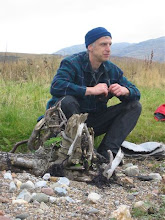



The fencers have finished a new fence out on the Moss. It fences off a piece of land on the west edge of Flanders that hasn't been grazed for many years. The aim is to get some sheep grazing onto it to increase the number of wildflowers you find there, the sheep removed the yearly grass growth, reduce the shady that the grass causes and thereby create gaps for wildflowers to grow into. This field is also right on the edge of the Moss so maybe act as a springboard for when we want to graze further out on the bog in the future. What is interesting is that for part of the length the fence runs along a slightly raised, straight bank. What is the story of this bank ? To find out you need to look at the historical maps and the Flanders Moss historical research project carried out by local historian John Harrison. It turns out that the bank was a land division put in in 1749 when a Mr. Hew Graeme, a local man and Edinburhg lawyer, bought the land. Mr. Graeme was a developer, different from the modern day developers in that he bought unproductive bogland that couldn't be farmer with the aim to turn it into productive farmland. He bought 2 parcels of land, the piece that we have fenced and a piece at Poldar Moss right next to where the boardwalk and car park is today. For 10 years he put in all his capital and considerable effort to try to turn a profit on the peat. At the Poldar Moss area he usedthe method of clayed moss, that is he (or his team of labourers) dug ditches across the peatland down to the clay and spread the clay he dug out onto the surface of the dried out bog and mized in with burned peat to make a soil. This was then ploughed with breast ploughs wrought by mean as the ground was too wet to bear oxen or horses. This he tried farming for a few years but after 10 years of toil his money ran out and he disappeared leaving the land to revert back to the people who sold it to them.
The fencers are local father and son team George and Alistair Watt from Gargunnock. They have done a large amount of fencing on the Moss and are well used to its soft, wet and wonderful ways. Last year they put up several 1000 yards of fencing out on the deep peat. Hard graft as it is too wet to do much by machine so a lot of the materials were carried out and put in by hand in waterlogged conditions. 200 years later, though they are doing a different task, the Watts labouring out on the Moss is very similar to the labouring done by Mr. Graeme's team but hopefully with more success.
